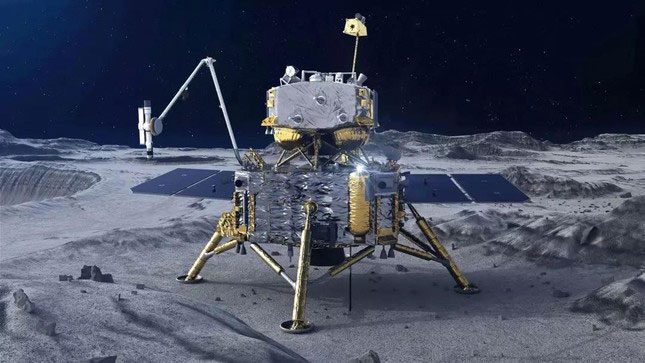China has recently approved a plan to conduct three unmanned lunar missions, following the discovery of a new mineral on the Moon that could serve as a future energy source, Politico reported on September 11.
The space race between China and the United States is accelerating after the China National Space Administration (CNSA) approved the launch of three lunar orbiters within the next decade, as announced on September 10. This information was first reported by Bloomberg. According to the Chinese newspaper Global Times, the announcement came just a day after China became the third country in the world to discover a new lunar mineral, which it has named Changesite-(Y).

China’s Chang’e 5 probe samples the Moon in 2020. (Photo: CGTN)
The Chang’e 5 spacecraft from China collected samples from the Moon in 2020. Global Times describes it as a “columnar crystal phosphate mineral” found within lunar rock grains. This mineral contains helium-3, which could be a potential energy source for the future.
This discovery could increase pressure on the United States to ramp up its efforts, especially after the launch of its Artemis I spacecraft to the Moon was delayed for the second time. Lunar mining could become the next source of tension between nations, as the National Aeronautics and Space Administration (NASA) is also exploring the Moon’s south pole, where China plans to establish a research station in collaboration with Russia. Recently, China has accelerated its space exploration efforts by constructing a space station, launching several lunar sample collection missions, and sending the Tianwen-1 probe to Mars earlier this year to compete with NASA.
12 People Have Walked on the Moon
According to NASA’s website, the United States remains the only country to have sent astronauts to the Moon, with the last landing occurring nearly 50 years ago during the Apollo 17 mission. Apollo 11 was the first spacecraft to bring samples from another celestial body back to Earth in July 1969, collecting approximately 22 kilograms of material from the lunar surface.
Among the 12 individuals who have walked on the Moon, the first was Neil Armstrong and the last was Gene Cernan. The lunar landings took place from July 1969 to December 1972 as part of the U.S. Apollo program, with all astronauts being U.S. citizens.
Alan Shepard was the oldest person to walk on the Moon, at the age of 47 years and 80 days. Charles Duke was the youngest, at 36 years and 201 days. Most astronauts at that time were active military personnel serving NASA; some exceptions included civilian astronauts who may have been former military members.


















































